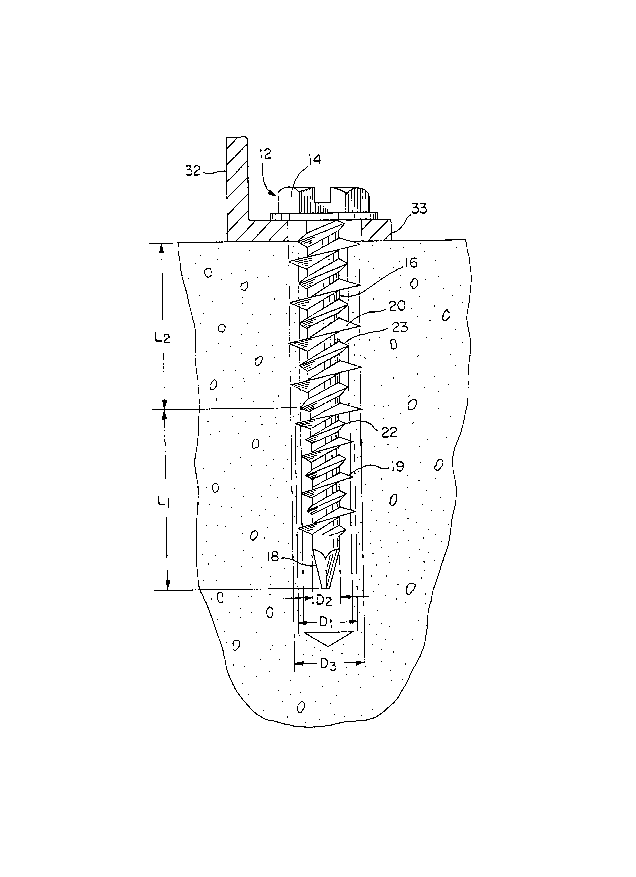Some of the information on this Web page has been provided by external sources. The Government of Canada is not responsible for the accuracy, reliability or currency of the information supplied by external sources. Users wishing to rely upon this information should consult directly with the source of the information. Content provided by external sources is not subject to official languages, privacy and accessibility requirements.
Any discrepancies in the text and image of the Claims and Abstract are due to differing posting times. Text of the Claims and Abstract are posted:
| (12) Patent: | (11) CA 2052667 |
|---|---|
| (54) English Title: | MASONRY SCREW ANCHOR |
| (54) French Title: | ANCRE DE MACONNERIE A VIS |
| Status: | Expired and beyond the Period of Reversal |
| (51) International Patent Classification (IPC): |
|
|---|---|
| (72) Inventors : |
|
| (73) Owners : |
|
| (71) Applicants : |
|
| (74) Agent: | NORTON ROSE FULBRIGHT CANADA LLP/S.E.N.C.R.L., S.R.L. |
| (74) Associate agent: | |
| (45) Issued: | 1995-01-17 |
| (22) Filed Date: | 1991-10-02 |
| (41) Open to Public Inspection: | 1992-04-04 |
| Examination requested: | 1992-03-17 |
| Availability of licence: | N/A |
| Dedicated to the Public: | N/A |
| (25) Language of filing: | English |
| Patent Cooperation Treaty (PCT): | No |
|---|
| (30) Application Priority Data: | ||||||
|---|---|---|---|---|---|---|
|
A masonry screw anchor having two
different constant diameter shank portions
connected via a taper. Each portion has a set of
constant diameter threads and intermediate smaller
diameter protrusions with the threads and
protrusions on the larger diameter shank portion
being larger in diameter than the diameter of the
threads and protrusions on the smaller diameter
portion.
Note: Claims are shown in the official language in which they were submitted.
Note: Descriptions are shown in the official language in which they were submitted.

2024-08-01:As part of the Next Generation Patents (NGP) transition, the Canadian Patents Database (CPD) now contains a more detailed Event History, which replicates the Event Log of our new back-office solution.
Please note that "Inactive:" events refers to events no longer in use in our new back-office solution.
For a clearer understanding of the status of the application/patent presented on this page, the site Disclaimer , as well as the definitions for Patent , Event History , Maintenance Fee and Payment History should be consulted.
| Description | Date |
|---|---|
| Inactive: IPC from MCD | 2006-03-11 |
| Inactive: IPC from MCD | 2006-03-11 |
| Time Limit for Reversal Expired | 2002-10-02 |
| Letter Sent | 2001-10-02 |
| Grant by Issuance | 1995-01-17 |
| Application Published (Open to Public Inspection) | 1992-04-04 |
| All Requirements for Examination Determined Compliant | 1992-03-17 |
| Request for Examination Requirements Determined Compliant | 1992-03-17 |
There is no abandonment history.
| Fee Type | Anniversary Year | Due Date | Paid Date |
|---|---|---|---|
| MF (patent, 6th anniv.) - standard | 1997-10-02 | 1997-09-10 | |
| MF (patent, 7th anniv.) - standard | 1998-10-02 | 1998-09-10 | |
| MF (patent, 8th anniv.) - standard | 1999-10-04 | 1999-09-20 | |
| MF (patent, 9th anniv.) - standard | 2000-10-02 | 2000-09-21 |
Note: Records showing the ownership history in alphabetical order.
| Current Owners on Record |
|---|
| EMHART INC., |
| Past Owners on Record |
|---|
| DAVID E. STARKE |
| FRANK PIACENTI |
| ROBERT W. BROWN |
| TONY L. DIXON |